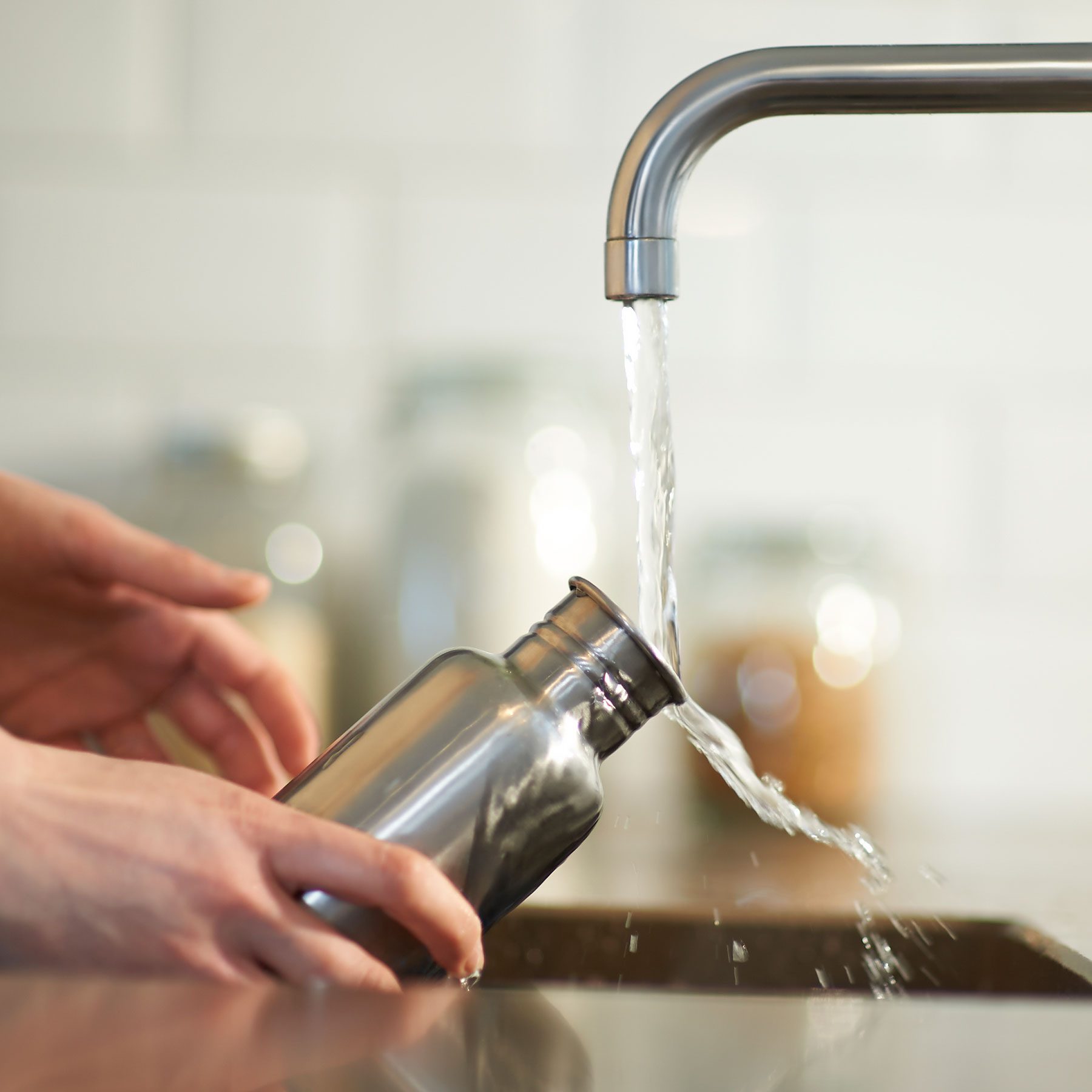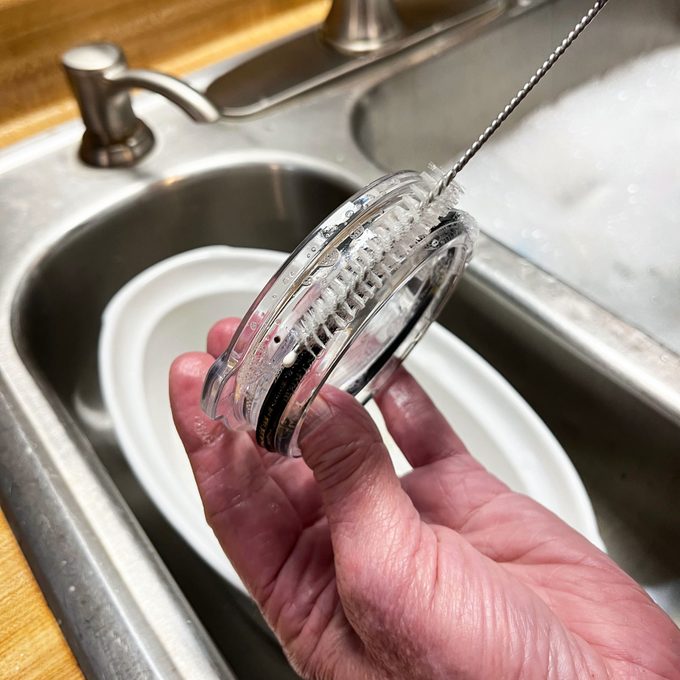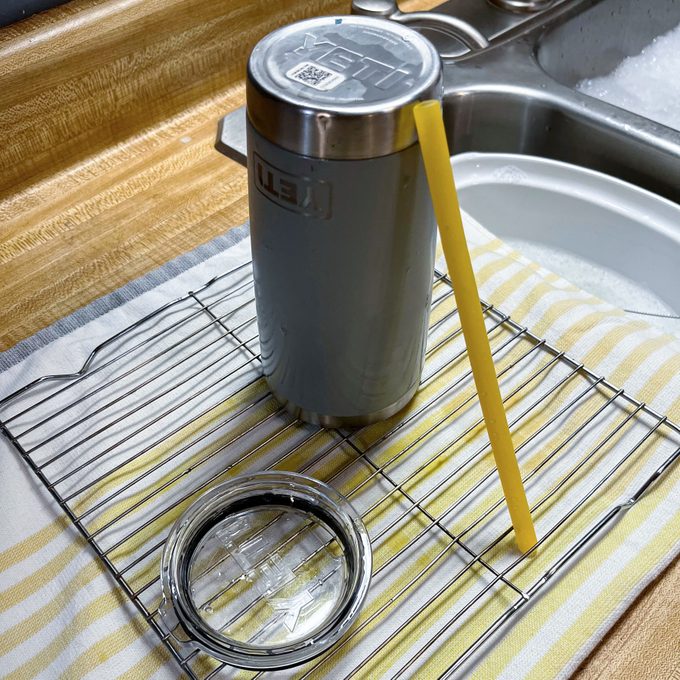Bacteria, buildup and gross smells begone! Here's how to clean a water bottle quickly and effectively, according to experts.
Our editors and experts handpick every product we feature. We may earn a commission from your purchases.Learn more.


Bacteria, buildup and gross smells begone! Here's how to clean a water bottle quickly and effectively, according to experts.
Our editors and experts handpick every product we feature. We may earn a commission from your purchases.Learn more.
Hold on to your sweatbands, everybody. If you don’t know how to clean a water bottle, you’re going to want to learn ASAP, because there’s a good chance your favorites are teeming with germs. In fact, the average bottle has 40,000 times more bacteria than a toilet seat—and 14 times more bacteria than your pet’s water bowl. (Considering where my dog’s tongue goes, I feel sick.) That’s according to 2022 study by Water Filter Guru, a group of scientists and other experts providing consumers with high-quality water research.
I know you’re thinking this can’t be true. Water bottles only hold water, right? I felt the same way. My mama pretty much taught me how to clean everything, and after years of writing about cleaning, I thought there wasn’t anything I wasn’t cleaning the right way—right down to my kitchen sponge. So it grieved my soul and aggravated my ulcer when I read that study. My friends, if you don’t know how to clean a water bottle or if you’ve been lax about cleaning yours, this article’s for you.
Reader’s Digest enlisted a microbiologist and two hands-on cleaning experts with decades of experience between them to find out what could happen if you’re not doing this cleaning task right. Ahead, we have all the tips and tricks on how to clean, sanitize and disinfect every type of water bottle—whether you have straw tops, screw tops, glass, plastic or stainless steel. We can drink to that!
Get Reader’s Digest’s Read Up newsletter for more cleaning, tech, travel, humor and fun facts all week long.
About the experts
|
One big culprit is backwash, according to cleaning expert Allen Rathey, director of the Indoor Health Council. When you drink from a water bottle, the water mixes with saliva and food particles, and all of that ends up back in the water bottle. “Microbes like moisture, darkness and a food supply—all of which are provided by a water bottle containing water, human saliva and other trace organic matter,” Rathey says. “Ditto for mold spores.”
Wait. There’s mold in water bottles too? I thought we were just dealing with bacteria. Unfortunately, mold loves moisture, and mold spores are everywhere. Indoors, outdoors, in your car and at the gym, mold spores are always floating around, just waiting to find a dark, moist place to land and reproduce. An open water-bottle lid, a flipped-up straw—if it’s exposed to the air, mold will see an opportunity and go for it. If your water bottle has slimy black or brown gunk inside it or in the crevices of the lid, it’s likely mold. And even before you see those telltale signs, spores are starting to form.
Then there are your grimy, unwashed hands on the bottle to consider. And if you have kids, they may be sharing water bottles, which exacerbates all of this. In other words: Life is dirty, and your water bottle is right in the middle of it.
The short answer: nothing good! Bacteria and molds that collect in dirty reusable water bottles can cause illnesses ranging from mild intestinal upset to serious allergic reactions and infections in vulnerable individuals. According to Pradip Panta, PhD, assistant professor of microbiology at Southeastern Louisiana University, these delightful disease-causing bacteria could include Escherichia coli, Vibrio cholerae, Salmonella enterica and Shigella flexneri. And molds are so ubiquitous, there’s no telling which species may find you.
One sign your bottle is a breeding ground for the bad stuff? Biofilm, the slimy goo that forms inside water bottles, including in straws and spouts. In a 2020 study published in MicrobiologyOpen, researchers even isolated a biofilm-forming bacteria species from a water bottle that was antibiotic-resistant! Viruses—from the flu to COVID—can cling to water bottles too.
While this may sound scary, our experts note that your risk depends on several factors, like your exposure level and personal vulnerability. A healthy young athlete may be totally fine after a long slug from a grubby water bottle, but “those who are immune-compromised can, at times, be sickened by just one or two colony-forming units (CFUs) of microbes,” Rathey says. Take extra care if you are cleaning for an older person or someone with an illness. “The severity of the impact of drinking dirty water depends on the quality of the water and the health of the person who drinks it,” Panta adds. But why take the chance? Even for healthy individuals, it’s important to put your water bottle on a regular cleaning schedule.
Daily, according to Panta and cleaning expert Alicia Sokolowski, president and co-CEO of AspenClean. “Aim to clean your water bottle at least once a day, especially if you use it for beverages other than water, like juice or smoothies,” Sokolowski says. Can’t remember the last time you cleaned your water bottle? Start today. Then, once a week, do a deep clean by adding a sanitization step. And if your water ever starts to smell or taste funky, don’t ignore it or think it’s just in your head. That’s a warning that your water bottle needs a good cleaning—stat.
This is an important point. Cleaning physically removes dirt and germs, and Rathey says it’s this scrubbing process that’s the most important step for your water bottle. (Just like washing your hands is better than only using hand sanitizer.) Sanitizing uses chemicals to reduce germ counts to safe levels, and disinfecting takes it one step further by killing most organisms on surfaces. The next step beyond that is sterilization, aka complete eradication of germs, but just tuck that away for your next round of Jeopardy! because you likely can’t accomplish this at home.
Unless you or your family members have compromised immune systems, cleaning and sanitizing are generally sufficient. The U.S. Environmental Protection Agency (EPA) registers approved sanitizers and disinfectants, but Rathey says “using a scrub brush and being thorough may be enough if you’re concerned about chemical exposure.” Just make sure to clean before sanitizing, because dirt and grime can prevent the chemicals from reaching the surface of the bottle.

Believe it or not, all you really need is hot water, dish detergent and a scrub brush. “The main intervention is the scrub brush, since biofilms form inside water bottles and on caps and closures, and brushing is the only way to break apart the sometimes-invisible colonies,” Rathey says. Avoid abrasive cleaners and scouring pads that can scratch the bottle’s interior. Gouges and scratches can harbor germs and grime, making your water bottle much harder to clean as time goes by. You’ll also need to follow special directions for the mouthpiece, so we’ll get to those in subsequent sections. But here are the basic steps for how to clean a water bottle, according to our experts.
| ♦ Pro tip |
| Don’t use drying mats to dry your water bottles. They hold moisture and prevent the inside from drying. Elevate your water bottle on a rack instead. |

Water-bottle lids range from simple screw tops to complicated spill-free bite valves, which require pressure on the spout—from your teeth or lips, hence the name—to release their contents. Sokolowski says it’s really important to clean the cap and mouthpiece thoroughly, as they can harbor bacteria and odors. Once a week, follow with a sanitizing step, which we’ll talk about after lid cleaning. Here’s how to clean popular water-bottle lids and straws.

While running your water bottle through a dishwasher on the hot cycle is the easiest option for those that are dishwasher-safe, you can also use diluted bleach or hydrogen peroxide. But if you go with the latter option, make sure to rinse thoroughly, says Rathey, since residue from these cleaners can cause allergic reactions and skin irritation. That’s why Sokolowski prefers natural sanitizing methods like plain white vinegar. Cleaning well and sanitizing with vinegar won’t kill every germ, but for most people, it’s sufficient.
But “if a person is immune-compromised, it’s important to use an EPA-registered sanitizer or disinfectant in addition to cleaning and scrubbing,” Rathey says. Always wash first to remove dirt, so the sanitizer can reach every surface of the bottle.
| ♦ Pro tip |
| Bleach can corrode stainless steel, so don’t use more bleach or soak for a longer time than indicated. Consider using a dishwasher or another sanitizing method for metal bottles. |
| ♦ Pro tip |
| Never combine hydrogen peroxide with other chemicals, including vinegar. These are two cleaning products you should never mix. |
| ♦ Pro tip |
| This method cleans and sanitizes the inside of the bottle, but you can also drop the tablets in a small container to sanitize the lid or accessories. |
Absolutely! Sokolowski and Rathey both endorse the dishwasher for cleaning and sanitizing your water bottle. (That’s what I do too.) Rathey says stainless steel and glass bottles work best here. For a plastic water bottle, look on the bottom of the bottle, in the instructions or on the manufacturer’s website to make sure it’s dishwasher-safe.
One thing I’ve learned from washing my own bottle in the dishwasher: I don’t recommend putting the reusable straw in the utensil section. After washing mine in the dishwasher, I ran a straw brush through it, and a brown film transferred onto the bristles. Instead, I’ve found that it’s better to clean the straw separately using a straw brush, dish detergent and water.

Plastic and silicone water bottles and accessories have one drawback over glass and stainless steel: They can absorb odors, including from your dish soap. “Soft plastic in water bottles is relatively porous compared to glass and stainless steel,” Rathey says. “Rinsing helps, but permeability to gases is the main reason they can smell funny.” Avoid that soapy taste from settling in with these tips:
Another option is to switch to a stainless steel water bottle. They’re easy to clean and less likely to absorb odors. They don’t break down either. “Stainless steel is best, all things considered,” says Rathey, “as it’s the most durable and scrubbable, and unlike plastic, it does not leach chemicals.”
For persistent odors that plain hot water can’t remove, Sokolowski suggests making a paste using baking soda and water. “Apply the paste to the bottle’s interior, let it sit for a few minutes, and then scrub and rinse thoroughly,” she says. If you can’t get your hand in the opening, apply it with a spatula, or make the paste a little thinner and scrub it in with your brush. Baking soda is a proven odor absorber, and it doesn’t have a smell. After letting it sit, scrub it with your bottle brush and rinse well.
Additional reporting by Ally Childress.
At Reader’s Digest, we’re committed to producing high-quality content by writers with expertise and experience in their field in consultation with relevant, qualified experts. For this piece, Karen Gibbs tapped her 20-plus years of experience as a cleaning writer, and then Ann Russell, TikTok’s “cleaning auntie” and the author of How to Clean Everything, gave it a rigorous review to ensure that all information is accurate and offers the best possible advice to readers. We verified all facts and data and backed them with credible sourcing, and we will revisit them over time to ensure they remain accurate and up to date. Read more about our team, our contributors and our editorial policies.
Sources: